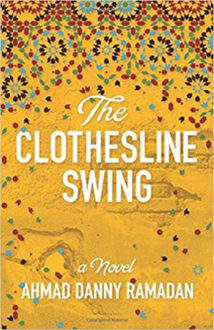 The Clothesline Swing
The Clothesline Swing
by Ahmad Danny Ramadan
Published by Nightwood
Published June 10, 2017 Fiction (magical realism) 288 pgs. • Find on Amazon.com • WorldCat
Reviewed by Stephen O. Murray
December 11, 2018Ahmad Danny Ramadan is a very hybrid name. The author (of two collections of stories published in Arabic and a 2017 novel published in Canada) was born in Damascus in 1984, he fled the civil war to Cairo and then Beirut before being sponsored by a gay Canadian to resettle (with his lover) in Vancouver. Given that the never-named narrator hakawati (storyteller) of The Clothesline Swing followed the same trajectory. On top of the supposition that first novels in the first person are autobiographical, the book seems like testimony more than it seems like fiction even set decades in the future—and even with Death as a character who is a personified presence.
With an estimated half million plus dead and more than ten million Syrians uprooted since 2011, Death probably seems omnipresent to many Syrians, especially to ones who were fag bashed before that, as Ramadan himself was in Cairo. Despite a similar nearly fatal bashing there, Cairo seems to have been more welcoming than Beirut, where Syrian refugees were widely despised and discriminated against.
The dying lover does not say much. Decades in the future, he is not obviously infected with HIV, though the dying homosexual and his devoted caregiver fits the AIDS template. The couple broke up for a while after immigrating to Canada. The narrator moldered in grief, while his partner partied and played, which also fits with this template.
Death hangs around, patiently, as the narrator tells stories to the dying lover. The stories entertain Death as well as providing a reason to stay alive (to hear more stories) to the beloved. Death also smokes a joint with the men and tells one story of his own.
Back before the uprising(s) against the Assad dynasty, the pair’s home was a party space for Damascus lesbians, the main one now living in Brazil. Even without being targeted, the lesbians and gay men had close brushes with bombings and gunfire. The narrator also recalls his mother’s descent into insanity and his father’s homophobia, which manifested itself early on as concern about the son’s fascination with cartoon superhero hunks in body-revealing tights. His parents’ rejection was offset by a loving grandmother, also a not very original concept. Neither is holding off death by telling stories; though Death is not personified and omnipresent in The Arabian Nights, Ramadan’s stories must intrigue both his lover and Death, not just a sultan who could slay Scheherazade.
The book has an unmemorable epigram from Gabriel García Marquez and could be classified as “magical realism” not in chronological order. The ground bass line of sorrow is lightened by some joyful memories and the devotion of the hakawati to keep telling stories to keep his lover alive. It recalls to my mind the oeuvre, not just, The Hakawati, the elegy for his native Beirut by Lebanese-American writer Rabid Alameddine. Both books (and Almeddine’s Kool-AIDS) have heavy sorrow about shattered Mediterranean urban cultures along with irony-nurtured wit and considerable lyricism about the lost city and the heavy casualties of repression and conflict. Happy endings? Not many, though survival is nearly miraculous for those who do survive. Ramadan’s is more a historical primer than Almeddine’s.
(BTW, there is a rooftop swing fashioned of clothesline and a pillow. The narrator’s father made it for his mother to swing on while maintaining her culturally mandated seclusion. The narrator’s lesbian friends seem to have managed to evade marriage, which is also mandated for men and women. The mandate leads to suicide in one of the stories of trying to be gay in Damascus before 2011.)
© 2018 by Stephen O. Murray. All rights reserved.

